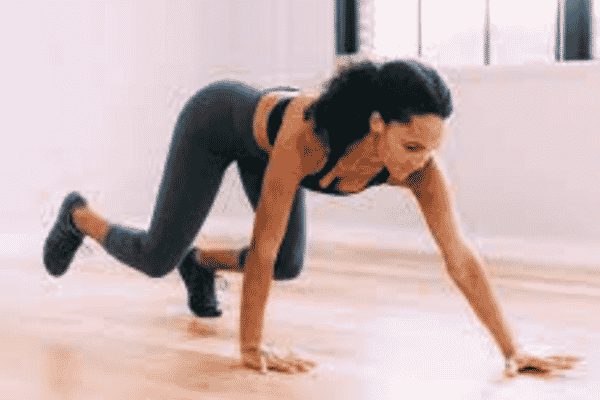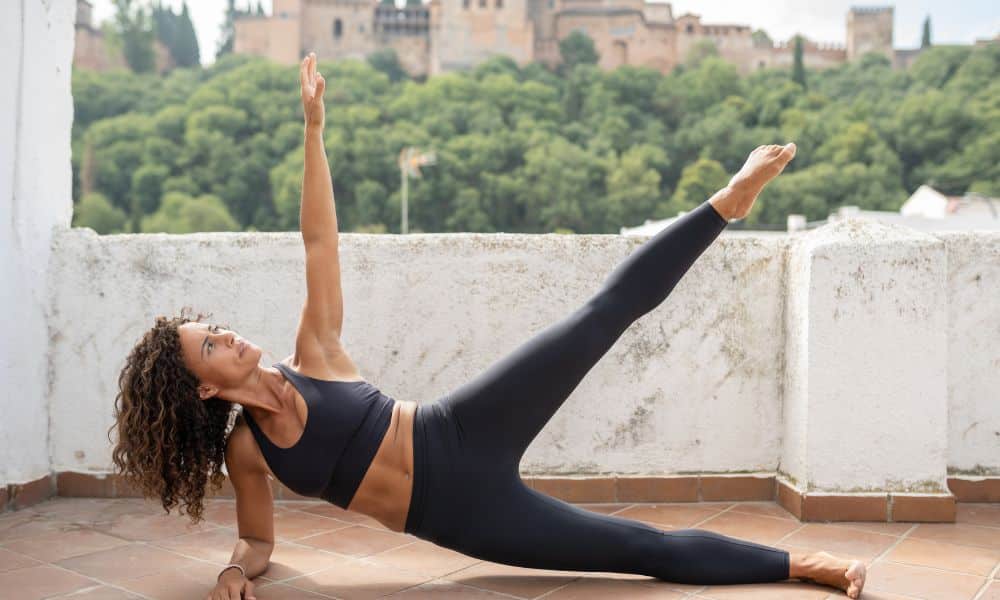A bear crawl is a body-weight mobility exercise. It emphasizes shoulder, quad, and abdominal muscle strength. It resembles a baby crawling. However, instead of using your knees, you must bear your weight on your hands and toes.
A bear crawl is a great way to improve core control. It also helps in raising your heart rate and burning calories. Besides boosting your metabolism, it is one of the best upper body exercises.

This exercise involves total body movement. That’s why the bear crawl movement works the muscles in the body. The muscles in your chest, arms, shoulders, upper back, and belly get worked as you complete this exercise.
It improves coordination, raises heart rate for cardiovascular advantages, and may help athletes perform better in various sports. However, this exercise is not for everyone. It requires balance, strength, and coordination to attempt the move.
How to Perform Bear Crawl Exercise?
This workout does not require the use of weights. However, you need a reasonable amount of space to perform this exercise. Therefore, it’s best if you can do it outside. Indoor venues, such as gyms or tennis courts, are also suitable.
The bear crawl will begin with you in a push-up position. Position your hands below your shoulders. The core is engaged, and the back is strong. The feet should be a hip distance apart, and the heels should be off the ground.
Here is the step-by-step guidance for performing the bear crawl exercise properly:
1: Begin moving forward by crawling forward with the help of your right hand and left leg simultaneously.
2: Now, switch sides. Put weight on the right hand and left leg. Now move the left hand and right leg immediately.
3: Continue crawling while keeping your body somewhat low. Assume you are crawling through a low brush.
To avoid any injury, perform each step slowly and carefully. Start with taking 5-7 degrees. Then, take a brief pause and try again. Gradually increase your movement distance.
Muscles Involved and Physical Activity Improved
- The bear crawl exercise engages the muscles across your body. These muscles include the shoulders (deltoids), chest, and back. Apart from these, the glutes, quads, hamstrings, and core muscles are also involved. If you perform this exercise regularly, you will develop strength and endurance.
- The bear crawl exercise also increases the heart rate. Thus, a bear crawl is also very helpful in maintaining cardiovascular fitness.
- The bear crawl is a part of SARQ training. SARQ stands for speed, agility, reactivity, and quickness. This is part of a training activity for professional athletes and military forces.
- This exercise improves physical fitness, visual vigilance, listening skills, and working memory.
- You don’t have to lift enormous weights to shape and strengthen your upper body. The weight of your body will suffice. Because this technique places most of your weight on your upper body, you’ll notice it right away in your arms, shoulders, and upper back. It’s a fantastic technique to tone your arms without special equipment.
Modifications and Variations
Bent Arm and Leg Bear Crawl
This method requires you to start in the standard bear crawl position. Now bend your arms and legs just a little. The advantage of this method is it builds tricep strength and provides a more efficient workout.
Jumping Bear Crawl
This method requires you to begin in the conventional frame position. Your knees and arms should be as straight as possible. Next, lift your left hand and right foot. Propel them forward several inches at the exact moment. The advantage of this method is it is a more advanced version that emphasizes the core.
Stationary Bear Crawl
This method requires you to get into a standard bear crawl position. First, lift your left hand and right foot off the floor. Hold this position for a few seconds. This method’s advantage is that it helps maintain posture and can be done in a limited space.
Sideways Bear Crawl
This method requires you to get into a standard bear crawl position. Then, move sideways instead of front and back. The advantage of this method is it provides posture and more emphasis on the core.
Safety Tips
- Make sure your muscles are warm. Engage your core correctly and stretch your spine. Otherwise, you are at risk of damaging your joints.
- Pregnant women may struggle with this exercise. This is because they carry more weight in the middle of their bodies. Hormones can also affect your joints, pelvis, and lower back stability. Consult your doctor for individualized guidance on whether to do the bear crawl with specific health conditions.
- People who have gained too much weight may have difficulty maintaining the bear crawl. However, starting with the tabletop variation is a great way to get the benefits of this exercise.
- If you have wrist or knee injuries, try avoiding this exercise. Bear crawl exercise places pressure on your wrists and knees.
The last word on the bear crawl exercise
It’s time to get your crawl on! The bear crawl is a great way to improve core control, raise your heart rate, and burn calories. This exercise involves total body movement, so the muscles in your chest, arms, shoulders, back, and abs get an all-around workout.
The bear crawl exercise is also good to do as a warm-up. It is a no-equipment workout that develops every muscle of your body. This exercise is done on the ground and can be altered in various ways to lower the intensity, such as tapping one knee down every few crawls for a respite or adding a reverse crawl to increase the effort.
Avoid this exercise if you have problems with your wrists, knees, or shoulders. Finally, if you’re new to the bear crawl exercise, work your way up to the complete crawl in phases to guarantee proper form. Share with us what your experience has been with this exercise. If you or someone you know is looking to improve your health, share this article on Facebook or Twitter so that others can learn more about self-care.




